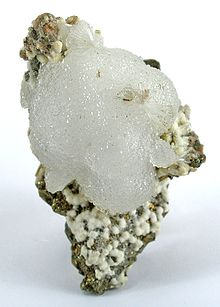| Tobermorite | |
|---|---|
 Crystalline mass of tobermorite | |
| General | |
| Category | Silicate mineral, Calcium silicate hydrate |
| Formula (repeating unit) | Ca5Si6O16(OH)2·4H2O, or; Ca5Si6(O,OH)18·5H2O |
| IMA symbol | Tbm[1] |
| Strunz classification | 9.DG.10 |
| Crystal system | Orthorhombic |
| Crystal class | Disphenoidal (222) H-M symbol: (2 2 2) |
| Space group | C2221 (no. 20) |
| Unit cell | a = 11.17 Å, b = 7.38 Å c = 22.94 Å; β = 90°; Z = 4 |
| Identification | |
| Formula mass | 702.36 g/mol |
| Color | Pale pinkish white, white, brown |
| Crystal habit | As minute laths; fibrous bundles, rosettes or sheaves, radiating or plumose, fine granular, massive. |
| Cleavage | {001} Perfect, {100} Imperfect |
| Mohs scale hardness | 2.5 |
| Luster | Vitreous, silky in fibrous aggregates |
| Streak | White |
| Diaphaneity | Translucent to translucent |
| Specific gravity | 2.423 – 2.458 |
| Optical properties | Biaxial (+) |
| Refractive index | nα = 1.570 nβ = 1.571 nγ = 1.575 |
| Birefringence | δ = 0.005 |
| Ultraviolet fluorescence | Fluorescent, Short UV:weak white to yellow, Long UV:weak white to yellow |
| References | [2][3][4] |
Tobermorite is a calcium silicate hydrate mineral with chemical formula: Ca5Si6O16(OH)2·4H2O or Ca5Si6(O,OH)18·5H2O.
Two structural varieties are distinguished: tobermorite-11 Å and tobermorite-14 Å. Tobermorite occurs in hydrated cement paste and can be found in nature as an alteration mineral in metamorphosed limestone and in skarn. It has been reported to occur in the Maqarin Area of north Jordan and in the Crestmore Quarry near Crestmore Heights, Riverside County, California.
Tobermorite was first described in 1880 for an occurrence in Scotland, on the Isle of Mull, around the locality of Tobermory.[3][5]
- ^ Warr, L.N. (2021). "IMA–CNMNC approved mineral symbols". Mineralogical Magazine. 85 (3): 291–320. Bibcode:2021MinM...85..291W. doi:10.1180/mgm.2021.43. S2CID 235729616.
- ^ Anthony, John W.; Bideaux, Richard A.; Bladh, Kenneth W.; Nichols, Monte C. (2005). "Tobermorite" (PDF). Handbook of Mineralogy. Mineral Data Publishing. Retrieved 27 July 2022.
- ^ a b Mineralogy Database, Mindat.org, retrieved 27 July 2022
- ^ Barthelmy, David (2014). "Lavendulan Mineral Data". Webmineral.com. Retrieved 27 July 2022.
- ^ Scottish physician and amateur mineralogist Matthew Forster Heddle (1828–1897) first described tobermorite in: Heddle (1880). "Preliminary notice of substances which may prove to be new minerals. Part second". Mineralogical Magazine and Journal of the Mineralogical Society. 4: 117–123. doi:10.1180/minmag.1880.004.18.04. See pp. 119–121.